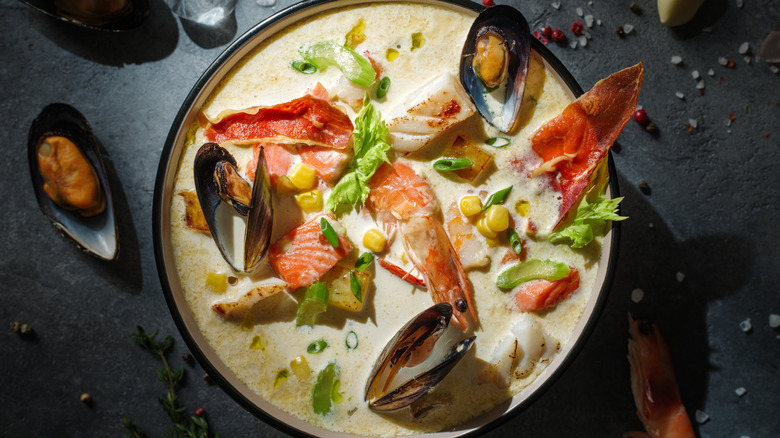How Irish Seafood Chowder Differs From New England Clam
Chowder, a soup that calls to mind fresh, briny seafood and a decadent creamy base, is a culinary treasure of epic proportions. Many coastal and island communities have their variation of this classic dish, from Bermudan fish chowder to New Zealand's pipi chowder.
Possibly derived from the Latin word calderia, meaning cauldron, chowder is first and foremost a seafood dish – the corn and chicken variety found in the Midwest notwithstanding. But which seafood stars in the chowder seems to be a regional preference.
In the American Northeast, the clam reigns supreme as the seafood of choice, whether the tomato-rich Manhattan clam chowder or the milky New England clam chowder. Things take a different route in Ireland as fish takes center stage. However, both variations will occasionally include all manners of fish, shellfish, and mollusks. As for the stew base, New England clam chowder and Irish seafood chowder go the creamy route. On the face of it, they look nearly identical. So what really sets these two chowders apart?
A tale of two chowders
The differences go back to the history of these two geographically divergent lands. On the one side, the Emerald Isle is surrounded by the turbulent Celtic and Irish seas, and on the other, the vast expanse of the Atlantic Ocean. With an enormous coastline, Ireland enjoys a plethora of fish, but, historically speaking, seafood is not a popular dish. Seafood chowder, in particular, was known as a "poor man's food."
In our more modern times, Irish seafood is enjoying a renaissance, with renewed interest in what the coast has to offer — and it offers plenty. For fish, you have salmon, haddock, pollock, monkfish, and hake; for shellfish, there are oysters, mussels, prawns, clams, and Irish brown crab.
Meanwhile, New England offers a cornucopia of clams, like Littlenecks, Cherry Stones, and Quahogs, the clam of choice for chowder. Made from cream, potatoes, onions, a bit of salt pork (or bacon), and clams, New England clam chowder has been a popular dish since the days of Herman Melville, who mentioned the dish in his magnum opus, "Moby Dick."
Still, clams and fish aside, one key ingredient defines the taste of the Irish seafood chowder versus the New England clam chowder.
Smoked fish is the ingredient that makes a difference
What truly distinguishes the two chowders is the addition of smoked fish to the Irish seafood chowder. Smoking fish is an ancient Irish culinary art; making hot-smoked fish, in particular hot-smoked salmon or hot-smoked haddock, is a common ingredient in Irish cookery. The Irish would smoke their prized salmon, trout, haddock, and mackerel to preserve them.
But there was also a delicious consequence to this food preservation tactic. Mimicking the aromatic qualities of bacon, smoked fish adds an unmistakable wood-fired flavor to the chowder, a complete departure from the cream-forward taste of New England clam chowder.
There are a few other distinctions between the two recipes. For instance, the Irish are also prone to reach for leeks, a milder allium option to white onions (the common American ingredient), to add to their chowder. And the creamy texture of the Irish chowder is less velvet-thick like the New England chowder and more delicately silky — think the textural difference between milk and heavy cream.
Ultimately, if you're looking to take a walk on the wild side and go smoky with your chowder, Irish seafood chowder is the perfect place to start.


